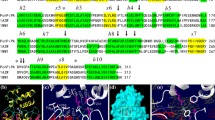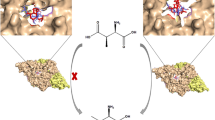Abstract
Aminopeptidase B (APB, EC 3.4.11.6) preferentially hydrolyzes basic amino acids of synthetic substrates and requires a physiological concentration of chloride anions for optimal activity. Several amino acid residues of APB responsible for its enzymatic activity have been elucidated. In this study, we further searched for residues critical to its enzymatic activity, especially toward peptide substrates. APB residues Tyr409 (Y409) and Tyr414 (Y414), both of which were critical to its hydrolytic activity toward synthetic substrates, were predicted by molecular modeling to be involved in cleaving peptide substrates via its interaction with amino acids in the P1′ cleavage site. Using site-directed mutagenesis, several mutant APBs were prepared. In contrast to synthetic substrates, wild-type and Y409F/Y414F double mutant enzymes showed P1′-dependent cleavage of peptide substrates, indicating that both tyrosine residues were not indispensable for hydrolytic activity toward peptide substrates. Moreover, the Y409F/Y414F double mutant enzyme cleaved peptides with a Pro residue at the P1′ site, which is uncommon among the M1 family of aminopeptidases. These results suggested that Tyr409 and Tyr414 of APB play important roles in enzymatic function and characteristic properties of APB via proper formation of the S1′ site.




Similar content being viewed by others
Abbreviations
- Ang:
-
Angiotensin
- APB:
-
Aminopeptidase B
References
Cadel S, Piesse C, Pham VL, Pernier J, Hanquez C, Gouzy-Darmon C, Foulon T (2013) Aminopeptidase B. In: Rawlings ND, Salvesen GS (eds) Handbook of proteolytic enzymes, 3rd edn. Academic Press, London, pp 473–479
Tsujimoto M, Hattori A (2005) The oxytocinase subfamily of M1 aminopeptidases. Biochim Biophys Acta 1751:9–18
Diaz-Perales A, Quesada V, Sanchez LM, Ugalde AP, Suarez MF, Fueyo A, Lopez-Otin C (2005) Identification of human aminopeptidase O, a novel metallopeptidase with structural similarity to aminopeptidase B and leukotriene A4 hydrolase. J Biol Chem 280:14310–14317
Maruyama M, Hattori A, Goto Y, Ueda M, Maeda M, Fujiwara H, Tsujimoto M (2007) Laeverin/aminopeptidase Q, a novel bestatin-sensitive leucine aminopeptidase belonging to the M1 family of aminopeptidases. J Biol Chem 282:20088–20096
Fukasawa KM, Fukasawa K, Harada M, Hirose J, Izumi T, Shimizu T (1999) Aminopeptidase B is structurally related to leukotriene-A4 hydrolase but is not a bifunctional enzyme with epoxide hydrolase activity. Biochem J 339:497–502
Thompson MW, Beasley KA, Schmidt MD, Seipelt RL (2009) Arginyl aminopeptidase-like 1 (RNPEPL1) is an alternatively processed aminopeptidase with specificity for methionine, glutamine, and citrulline residues. Protein Pept Lett 16:1256–1266
Maruyama M, Arisaka N, Goto Y, Ohsawa Y, Inoue H, Fujiwara H, Hattori A, Tsujimoto M (2009) Histidine 379 of human laeverin/aminopeptidase Q, a nonconserved residue within the exopeptidase motif, defines its distinctive enzymatic properties. J Biol Chem 284:34692–34702
Cadel S, Pierotti AR, Foulon T, Creminon C, Barre N, Segretain D, Cohen P (1995) Aminopeptidase-B in the rat testes: isolation, functional properties and cellular localization in seminiferous tubules. Mol Cell Endocrinol 110:149–160
Hwang SR, O’Neill A, Bark S, Foulon T, Hook V (2007) Secretary vesicle aminopeptidase B related to neuropeptide processing: molecular identification and subcellular localization to enkephalin- and NPY-containing chromaffin granules. J Neurochem 100:1340–1350
Fontes G, Lajoix AD, Bergeron F, Cadel S, Prat A, Foulon T, Gross R, Dalle S, Le-Nguyen D, Tribillac F, Bataille D (2005) Miniglucagon (MG)-generating endopeptidase, which processes glucagon into MG, is composed of N-arginine dibasic convertase and aminnopeptidase B. Endocrinology 146:702–712
Beinfeld M, Funkelstein L, Foulon F, Cadel S, Kitagawa K, Toneff T, Reinheckel T, Peters C, Hook V (2009) Cathepsin L plays major role in cholecystokinin production in mouse brain cortex in pituitary AtT-20 cells: protease gene knockout and inhibitor studies. Peptides 30:1882–1891
Pharm VL, Cadel MS, Gouzy-Darmon C, Hanquez C, Beinfeld MC, Nicolas P, Etchebest C, Foulon T (2007) Aminopeptidase B, a glucagon-processing enzyme: site directed mutagenesis of the Zn2+-binding motif and molecular modeling. BMC Biochem 8:21
Pharm VL, Gouzy-Darmon C, Pernier J, Hanquez C, Hook V, Beinfeld MC, Nicolas P, Foulon T, Cadel S (2011) Mutation in the substrate-binding site of aminopeptidase B confers new enzymatic properties. Biochimie 93:730–741
Cadel S, Darmon C, Pernier J, Hervé G, Foulon T (2015) The M1 family of vertebrate aminopeptidases: role of evolutionarily conserved tyrosines in the enzymatic mechanism of aminopeptidase B. Biochimie 109:67–77
Fukasawa KM, Hirose J, Hata T, Ono Y (2006) Aspartic acid 405 contributes to the substrate specificity of aminopeptidase B. Biochemistry 45:11425–11431
Ogawa Y, Ohnishi A, Goto Y, Sakuma Y, Watanabe J, Hattori A, Tsujimoto M (2014) Role of glutamine-169 in the substrate recognition of human aminopeptidase B. Biochim Biophys Acta 1840:1872–1881
Ohnishi A, Watanabe J, Ogawa Y, Goto Y, Hattori A, Tsujimoto M (2015) Involvement of phenylalanine 297 in the construction of the substrate pocket of human aminopeptidase B. Biochemistry 54:6062–6070
Hattori A, Kitatani K, Matsumoto H, Miyazawa S, Rogi T, Tsuruoka N, Mizutani S, Natori Y, Tsujimoto M (2000) characterization of recombinant human adipocyte-derived leucine aminopeptidase expressed in Chinese hamster ovary cells. J Biochem 128:755–762
Guasp P, Barnea E, Gonzalez-Escribano MF, Jimenez-Reisono A, Regueiro JR, Adomon A, Lopez de Castro JA (2017) The Behcet’s disease-associated variant of the aminopeptidase ERAP1 sharps a low-affinity HLA-B*51 peptidome by differential subpeptidome processing. J Biol Chem 292:9680–9689
Adomon A (2019) ERAP1 sharps just part of the immunopeptidome. Hum Immunol 80:296–301
Chen H, Li L, Weimershaus M, Evonouchidou I, van Endert P, Bouvier M (2016) ERAP1-ERAP2 dimer trim MHC I-bound precursor peptides; implications for understanding peptide editing. Sci Rep 12:28902
Vazeux G, Iturrioz X, Corvol P, Llorens-Cortes C (1998) A glutamate residue contributes to the exopeptidase specificity in aminopeptidase A. Biochem J 334:407–413
Luciani N, Marie-Claire C, Ruffet E, Beaumont A, Roques BP, Fournie-Zaluski MC (1998) Characterization of Glu350 as a critical residue involved in the N-terminal amine binding site of aminopeptidase N (EC 3.4.11.2): insights into its mechanism of action. Biochemistry 37:686–692
Acknowledgement
This work was supported in part by a Grant-in-aid from the Ministry of Education, Culture, Sports, Science and Technology of Japan (Project Number: 25293083).
Author information
Authors and Affiliations
Corresponding author
Ethics declarations
Conflict of interest
The authors declare that they have no conflicts of interest concerning this article.
Additional information
Publisher's Note
Springer Nature remains neutral with regard to jurisdictional claims in published maps and institutional affiliations.
Rights and permissions
About this article
Cite this article
Ohnishi, A., Watanabe, J. & Tsujimoto, M. Importance of Tyr409 and Tyr414 in constructing the substrate pocket of human aminopeptidase B. Mol Cell Biochem 469, 1–8 (2020). https://doi.org/10.1007/s11010-020-03722-w
Received:
Accepted:
Published:
Issue Date:
DOI: https://doi.org/10.1007/s11010-020-03722-w




